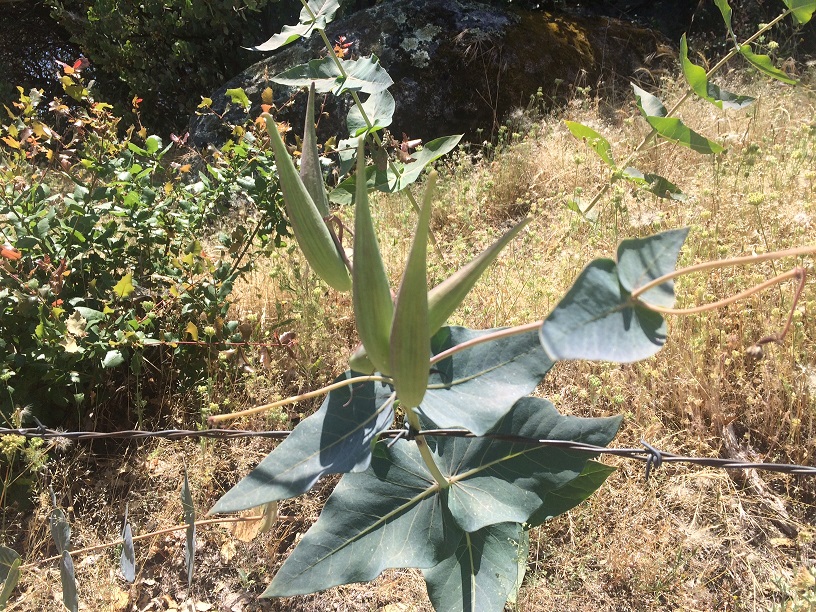

Photo copyright © 2019 Mariposa Native Plants
A native perennial herb, with dark reddish-purple flower clusters and heart-shaped leaves arranged oppositely on a long, stiff stem. The plant emerges in the spring and thrives throughout the hot summer, relying upon its deep root system. It produces large seed follicles later in the summer, typically in August or early September, which break open to disperse seeds attached to white, fluffy fibers. A.cordifolia is winter deciduous. But, as a perennial, it comes back year after year and adds an exotic accent to any California native plant garden. Along with several other species in the Asclepias genus, this plant is a host for the monarch butterfly caterpillar. Some plants have a distinctly purplish leaf color, but this is by no means common in and around Mariposa County.
A.cordifolia is found in diverse environments in California, Oregon, and Nevada. Within California, it grows in the Coast Range north of the Bay Area, in the northern mountains, and on the western slope of the Sierra Nevada. Elevation: sea level to above 9,000 ft. (3000m). Sun: full or partial. Temperature: cold tolerant to 15°F (-10°C). Soil: prefers sandy, rocky, and decomposed granite soils; pH 6-8.
Try to get Heartleaf Milkweed in the ground as soon as is practical; As with other milkweeds A.cordifoliaa does not like life in the container. It might be prudent to protect young plants with a gopher cage in the ground and a deer screen above ground. As the plants get older, they develop more of the internal toxic latex sap, and they become unpalatable to herbivores. However, Heartleaf Milkweed is easy to care for once established. It prefers a site that is well-drained. Roots are sensitive to disturbance; avoid breaking the root ball when planting from the container. Water (1 gallon, 4 liters) once per week until the first winter's soaking rain. Water once per month, same amounts, in the second summer. Thereafter, no supplemental water required. This milkweed can grow to be 3-4 feet tall (1-1.3m). A.cordifolia propagates through seeds, so it can be planted in garden and expected to maintain its space. Again, the Heartleaf Milkweed is a host plant for the monarch butterfly caterpillar, so it's possible that the plant can be devoured by caterpillars should the monarchs visit. The good news is that the plants have adapted to this predation, and they bounce back quite quickly.
A.cordifolia is a host plant for the monarch butterfly's caterpillars. Milkweeds, and A.cordifolia among them, contain within them an alkaloid that is mildly poisonous and distasteful to birds and other predators. However, the monarch has adapted to this natural fact, and the caterpillars can feed on the milkweed leaves and fine stems, absorb the alklaoid, and become quite unpalatable to predators.
Aphids: Young plants especially are subject to aphids. Brush the aphids off gently by hand, with a soft brush, or with a spray of water from the garden hose. Please do not use pesticides on A.cordifolia, because these chemicals harm the monarch butterfly caterpillars. California native plants are adapted to withstand the insect pests, and they really don't need chemical help from you to do so. Also, the aphids are a prime food target for the helpful ladybug insect, so leaving a few of them on the plant confirms an established food and life cycle.
Gophers: Might eat at the roots of A.cordifolia. It's a good practice to protect young plants with an in-ground gopher cage.
Deer and rabbits: Might browse on young Heartleaf Milkweeds. Protect young plants with an above-ground screen that is staked to the earth. Once the milkweed is mature (2-3 years), deer and rabbits should not be a problem.
This milkweed gets its name from the oppositely arranged, heart-shaped leaves on the long, stiff stem. It is also called Purple Milkweed. But it should not be confused with a milkweed found in Eastern North America, which is also called "Purple Milkweed": Asclepias purpurascens.
#1 container (about 1 gallon).
Seeds (24 per package).